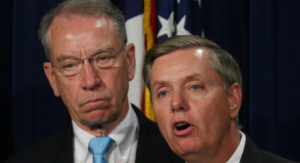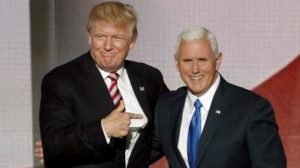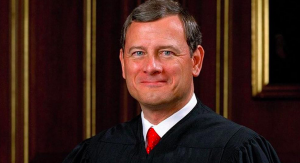The New York Times today takes a deep-dive analysis into how Donald Trump, aided by “The Enemy of The People,” Senate Majority Leader Mitch McConnell, has Unleashed a Conservative Agenda on the Federal Courts:
As a Republican candidate for the Texas Supreme Court, Don R. Willett flaunted his uncompromising conservatism, boasting of endorsements from groups with “pro-life, pro-faith, pro-family” credentials.
“I intend to build such a fiercely conservative record on the court that I will be unconfirmable for any future federal judicial post — and proudly so,” a Republican rival quoted him telling party leaders.
Judge Willett served a dozen years on the Texas bench. But rather than disqualifying him, his record there propelled him to the very job he had deemed beyond reach. President Trump nominated him to a federal appeals court, and Republicans in the Senate narrowly confirmed him on a party-line vote.
As Mr. Trump seeks re-election, his rightward overhaul of the federal judiciary — in particular, the highly influential appeals courts — has been invoked as one of his most enduring accomplishments. While individual nominees have drawn scrutiny, The New York Times conducted a deep examination of all 51 new appellate judges to obtain a collective portrait of the Trump-populated bench.
The review shows that the Trump class of appellate judges, much like the president himself, breaks significantly with the norms set by his Democratic and Republican predecessors, Barack Obama and George W. Bush.
The lifetime appointees — who make up more than a quarter of the entire appellate bench — were more openly engaged in causes important to Republicans, such as opposition to gay marriage and to government funding for abortion.
They more typically held a political post in the federal government and donated money to political candidates and causes. Just four had no discernible political activity in their past, and several were confirmed in spite of an unfavorable rating from the American Bar Association — the first time that had happened at the appellate level in decades.
Two-thirds are white men, and as a group, they are much younger than the Obama and Bush appointees.
Once on the bench, the Trump appointees have stood out from their fellow judges, according to an analysis by The Times of more than 10,000 published decisions and dissents through December.
When ruling on cases, they have been notably more likely than other Republican appointees to disagree with peers selected by Democratic presidents, and more likely to agree with those Republican appointees, suggesting they are more consistently conservative. Among the dozen or so judges that most fit the pattern, The Times found, are three Mr. Trump has signaled were on his Supreme Court shortlist.
While the appellate courts favor consensus and disagreement remains relatively rare — there were 125 instances when a Trump appointee wrote the majority opinion or dissent in a split decision — the new judges have ruled on disputed cases across a range of contentious issues, including abortion, immigration, L.G.B.T. rights and lobbying requirements, the examination shows.
One new judge, who had held a political job in the Trump administration, dissented on an issue of particular importance to the president: disclosure of his financial records. The judge, Neomi Rao, opposed a decision requiring the release of the documents to a congressional committee, a mandate the president continues to resist and is now before the Supreme Court.
“They have long records of standing up, and they’re not afraid of being unpopular,” said Carrie Severino, president of the Judicial Crisis Network, a conservative advocacy group that has pushed for the mold-breaking appointments. Ms. Severino once served as a law clerk for Justice Clarence Thomas, one of the Supreme Court’s most reliably conservative members.
Justice Clarence Thomas and his conservative activist wife are the role model for these conservative activist judges. Trump’s ‘Deep State’ purge list compiled by the wife of Justice Clarence Thomas.
Stephen B. Burbank, a law professor at the University of Pennsylvania, said Mr. Trump’s appointments reflected attempts by recent presidents to draw the federal judiciary — a constitutionally independent branch of government — into policy debates more appropriate in Congress and the White House.
“The problem as I see it is not that judges differ ideologically — of course they do — nor is it that a Republican president would look for someone with congenial ideological preferences,” Mr. Burbank said. “It’s that in recent decades the search has been for hard-wired ideologues because they’re reliable policy agents.”
The Times examination was based on interviews with dozens of people close to the nomination process, including some of Mr. Trump’s appointees; the analysis of thousands of publi shed decisions and dissents since Mr. Trump became president; a review of detailed biographical and financial questionnaires submitted by all 168 appellate judges named by Mr. Trump, Mr. Obama and Mr. Bush, as well as their records, public statements and campaign contributions since 1989.
Judicial appointments, a standard measure of a president’s legacy, almost always draw partisan scrutiny, as Republicans tend to appoint conservative lawyers who interpret the Constitution according to what they say was its original meaning, and Democrats lean toward liberal appointees with a more expansive view. But Mr. Trump’s record is particularly striking because of the divisive atmosphere, the examination shows, and the president’s disruptive approach to governing. The White House did not respond to requests for comment, and none of the judges contacted by The Times would agree to be quoted.
When Mr. Trump took office there were 103 unfilled federal court openings, in addition to a Supreme Court seat, in part because Senator Mitch McConnell of Kentucky, the Republican leader of the Senate, and allies had [unconstitutionally] refused to proceed with confirming many of Mr. Obama’s nominees. The last time so many vacancies had been left to a successor of the opposing party was when the federal bench was expanded by dozens of judges under President George H.W. Bush.
Mr. Trump wasted no time in seizing the opportunity. During his first three years in office, with Mr. McConnell’s assistance, he was able to name nearly as many appellate judges as Mr. Obama had appointed over two terms.
And he did so with great political flourish. More than one-third of the Trump appointees have filled seats previously occupied by judges appointed by Democrats, tipping the balance toward conservatives in some circuits that include largely Democratic states like New York and Connecticut. Even in the San Francisco-based Ninth Circuit, a reliably liberal appeals court, Mr. Trump has significantly narrowed the gap between judges appointed by Democratic and Republican presidents.
* * *
Two-thirds of the new appellate judges failed to win the support of 60 senators, historically a requirement of consensus that was first jettisoned by the Democratic-controlled Senate midway through the Obama administration because Republicans were blocking nominees to the D.C. Circuit. After he became majority leader, Mr. McConnell followed suit when Democrats initially blocked Mr. Trump’s first Supreme Court nominee, Neil Gorsuch.
 About a third did not receive the signoff of both home-state senators, a courtesy for a nomination to move forward that was tossed aside in late 2017 by Senator Charles E. Grassley of Iowa, then the Judiciary Committee’s Republican chairman. Senator Lindsey Graham of South Carolina, Mr. Grassley’s successor in that role, carried the decision forward. Crucially, that meant Mr. Trump did not have to compromise on his appellate picks in states with a Democratic senator.
About a third did not receive the signoff of both home-state senators, a courtesy for a nomination to move forward that was tossed aside in late 2017 by Senator Charles E. Grassley of Iowa, then the Judiciary Committee’s Republican chairman. Senator Lindsey Graham of South Carolina, Mr. Grassley’s successor in that role, carried the decision forward. Crucially, that meant Mr. Trump did not have to compromise on his appellate picks in states with a Democratic senator.
Just two found unanimous support across the aisle, a sharp drop from both the Obama and Bush nominees.
According to a tally by the Heritage Foundation, a conservative policy group, Mr. Trump’s appointees across the judiciary have drawn three times more “no” votes in the Senate than all confirmed judges in the 20th century combined. So far, Mr. Trump has appointed more than 185 federal judges.
On the appellate bench, Mr. Trump’s appointees have drawn nearly twice as many “no” votes as did those of Mr. Bush and Mr. Obama, The Times’s analysis shows.
 In a history-making intervention, one of Mr. Trump’s appellate picks was confirmed only when Vice President Mike Pence broke a 50-50 deadlock. It was Mr. Pence’s 12th tiebreaking vote in the Senate, the most of anyone in his office since the 1870s, and the only time a vice president installed a nominee to the bench.
In a history-making intervention, one of Mr. Trump’s appellate picks was confirmed only when Vice President Mike Pence broke a 50-50 deadlock. It was Mr. Pence’s 12th tiebreaking vote in the Senate, the most of anyone in his office since the 1870s, and the only time a vice president installed a nominee to the bench.
The judge, Jonathan A. Kobes, had been working on Capitol Hill as an aide to a Republican senator. He was rated unqualified by the American Bar Association, which questioned his ability to reflect “complex legal analysis” and “knowledge of the law” in his writing.
He got the job anyway, with Mr. Grassley proclaiming on Twitter in December 2018 that the confirmation had “made HISTORY.” Judge Kobes became Mr. Trump’s 30th confirmed appointee to the appellate bench.
* * *
Mr. Trump has staked his presidency on upending conventions, and his approach to the judiciary breaks sharply with that of past presidents.
He unapologetically views judges as agents of the presidents who appointed them — calling out an “Obama judge,” for instance, for ruling against the Trump administration in an immigration case. He frequently attributes his popularity among Republicans to his judicial appointments. And he has not been shy about politicizing the process.
“95% Approval Rating in the Republican Party,” he wrote on Twitter in January. “Thank you! 191 Federal Judges (a record), and two Supreme Court Justices, approved.
[I]n his State of the Union address in February, he bragged about his judicial appointments, promising, “We have many in the pipeline.” A week later, the Senate approved his 51st nominee to the appeals bench; 41 others now await votes for the lower courts.
 While federal judges of all stripes take an oath of impartiality and reject the notion that they do a president’s bidding — Chief Justice John G. Roberts Jr. recently described an independent judiciary as “a key source of national unity and stability” — the examination by The Times shows that the Trump administration has filled the appellate courts with formidable allies who fought for a range of issues important to Republicans.
While federal judges of all stripes take an oath of impartiality and reject the notion that they do a president’s bidding — Chief Justice John G. Roberts Jr. recently described an independent judiciary as “a key source of national unity and stability” — the examination by The Times shows that the Trump administration has filled the appellate courts with formidable allies who fought for a range of issues important to Republicans.
There is much more in this deep-dive analysis by The Times which you should read, but this is an inflection point where I want to turn to this reporting from Supreme Court reporter Dahlia Lithwick. Former Judge Resigns From the Supreme Court Bar:
James Dannenberg is a retired Hawaii state judge. He sat on the District Court of the 1st Circuit of the state judiciary for 27 years. Before that, he served as the deputy attorney general of Hawaii. He was also an adjunct professor at the University of Hawaii Richardson School of Law, teaching federal jurisdiction for more than a decade. He has appeared on briefs and petitions as part of the most prestigious association of attorneys in the country: the Supreme Court Bar. The lawyers admitted to practice before the high court enjoy preferred seating at arguments and access to the court library, and are deemed members of the legal elite. Above all, the bar stands as a sprawling national signifier that the work of the court, the legitimacy of the institution, and the business of justice is bolstered by tens of thousands of lawyers across the nation.
On Wednesday, Dannenberg tendered a letter of resignation from the Supreme Court Bar to Chief Justice John Roberts. He has been a member of that bar since 1972. In his letter, reprinted in full below, Dannenberg compares the current Supreme Court, with its boundless solicitude for the rights of the wealthy, the privileged, and the comfortable, to the court that ushered in the Lochner era in the early 20th century, a period of profound judicial activism that put a heavy thumb on the scale for big business, banking, and insurance interests, and ruled consistently against child labor, fair wages, and labor regulations.
Note: I warned you about the revisionist “conservative” movement to revive the long-discredited Lochner era which favored corporations and wealthy oligarchs over individual rights back in 2015. George Will’s radical ‘litmus test’ for a return to the Lochner era.
Here is Judge James Dannenberg’s letter of resignation from Supreme Court Bar:
The Chief Justice of the United States
One First Street, N.E.
Washington, D.C. 20543
March 11, 2020
Dear Chief Justice Roberts:
I hereby resign my membership in the Supreme Court Bar.
This was not an easy decision. I have been a member of the Supreme Court Bar since 1972, far longer than you have, and appeared before the Court, both in person and on briefs, on several occasions as Deputy and First Deputy Attorney General of Hawaii before being appointed as a Hawaii District Court judge in 1986. I have a high regard for the work of the Federal Judiciary and taught the Federal Courts course at the University of Hawaii Richardson School of Law for a decade in the 1980s and 1990s. This due regard spanned the tenures of Chief Justices Warren, Burger, and Rehnquist before your appointment and confirmation in 2005. I have not always agreed with the Court’s decisions, but until recently I have generally seen them as products of mainstream legal reasoning, whether liberal or conservative. The legal conservatism I have respected– that of, for example, Justice Lewis Powell, Alexander Bickel or Paul Bator– at a minimum enshrined the idea of stare decisis and eschewed the idea of radical change in legal doctrine for political ends.
I can no longer say that with any confidence. You are doing far more— and far worse– than “calling balls and strikes.” You are allowing the Court to become an “errand boy” for an administration that has little respect for the rule of law.
The Court, under your leadership and with your votes, has wantonly flouted established precedent. Your “conservative” majority has cynically undermined basic freedoms by hypocritically weaponizing others. The ideas of free speech and religious liberty have been transmogrified to allow officially sanctioned bigotry and discrimination, as well as to elevate the grossest forms of political bribery beyond the ability of the federal government or states to rationally regulate it. More than a score of decisions during your tenure have overturned established precedents—some more than forty years old– and you voted with the majority in most. There is nothing “conservative” about this trend. This is radical “legal activism” at its worst.
Without trying to write a law review article, I believe that the Court majority, under your leadership, has become little more than a result-oriented extension of the right wing of the Republican Party, as vetted by the Federalist Society. Yes, politics has always been a factor in the Court’s history, but not to today’s extent. Even routine rules of statutory construction get subverted or ignored to achieve transparently political goals. The rationales of “textualism” and “originalism” are mere fig leaves masking right wing political goals; sheer casuistry.
Your public pronouncements suggest that you seem concerned about the legitimacy of the Court in today’s polarized environment. We all should be. Yet your actions, despite a few bromides about objectivity, say otherwise.
It is clear to me that your Court is willfully hurtling back to the cruel days of Lochner and even Plessy. The only constitutional freedoms ultimately recognized may soon be limited to those useful to wealthy, Republican, White, straight, Christian, and armed males— and the corporations they control. This is wrong. Period. This is not America.
I predict that your legacy will ultimately be as diminished as that of Chief Justice Melville Fuller, who presided over both Plessy and Lochner. It still could become that of his revered fellow Justice John Harlan the elder, an honest conservative, but I doubt that it will. Feel free to prove me wrong.
The Supreme Court of the United States is respected when it wields authority and not mere power. As has often been said, you are infallible because you are final, but not the other way around.
I no longer have respect for you or your majority, and I have little hope for change. I can’t vote you out of office because you have life tenure, but I can withdraw whatever insignificant support my Bar membership might seem to provide.
Please remove my name from the rolls.
With deepest regret,
James Dannenberg
This is a clarion call warning of the damage Republicans have done to the independence and impartiality of the federal judiciary in their efforts to politicize the courts in a litmus test of GOP tribalism loyalty, i.e., authoritarianism to maintain their tyranny of the minority.
Discover more from Blog for Arizona
Subscribe to get the latest posts sent to your email.
